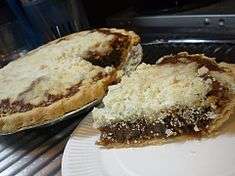Shoofly pie
 | |
| Alternative names | Shoo-fly pie |
|---|---|
| Type | Pie |
| Place of origin | United States |
| Region or state | Pennsylvania |
| Main ingredients | Pie shell, molasses |
| Variations | Montgomery pie, chess pie |
|
| |
Shoofly pie (or shoo-fly pie)[1] is a molasses pie or cake that developed its traditional form among the Pennsylvania Dutch in the 1880s, who ate it with strong black coffee for breakfast.[2][3] It is called Melassich Riwwelboi or Melassichriwwelkuche (molasses crumb cake) in the Pennsylvania Dutch language.[4]
Description
Shoofly pie is a molasses (also called dark treacle) crumb cake that was baked in a pie crust.[3] The addition of a pie crust made it easier for people to hold a piece in the hand while eating it.[3]
It comes in two different versions: wet bottom and dry bottom. The dry-bottom version is baked until fully set and results in a more cake-like consistency throughout. The wet-bottom version is set like cake at the top where it was mixed in with the crumbs, but the very bottom is a stickier, gooier custard-like consistency.[5]
A Montgomery pie is similar to a shoofly pie, except lemon juice is usually added to the bottom layer and buttermilk to the topping. Treacle tart is a pie with a filling made from light treacle.
History and name
Shoofly pie began as a crust-less molasses cake called Centennial Cake in 1876, to celebrate the 100th anniversary of the signing of the Declaration of Independence in Philadelphia.[3] In the 1880s, home bakers added a crust to make it easier to eat alongside a cup of coffee in the morning, without plates and forks.[3][2] Precursors include Jenny Lind Cake, a gingerbread cake from the middle of the 19th century.[2]
Because the cake contains molasses but no eggs, historians conclude that it was typically baked during the winter, when hens laid no eggs but when molasses would store well in the cold weather.[2] The use of baking powder places its invention firmly after the Civil War and in the 1870s, when Pennsylvania Dutch bakers began using baking powder.[2]
The name comes from a particular brand of molasses, called Shoofly Molasses.[3] This brand was named after a popular circus animal that toured in Pennsylvania in the 19th century, Shoofly the Boxing Mule.[3] The mule, in turn, may have been named after a song that became popular half a century before: Shoo Fly, Don't Bother Me.[3]
In popular culture
The dish is mentioned in the song "Shoo-Fly Pie and Apple Pan Dowdy," popularized by Dinah Shore in the 1940s.
In the final episode of Welcome Back, Kotter, "The Bread Winners", Beau De LaBarre brings a Shoofly Pie to a Sweathog dinner party.
References
- ↑ The Encyclopedia of American Food & Drink (ISBN 0-86730-784-6), by John Mariani.
- 1 2 3 4 5 Weaver, William Woys (2013). As American as Shoofly Pie: The Foodlore and Fakelore of Pennsylvania Dutch Cuisine. University of Pennsylvania Press. pp. 221, 256. ISBN 9780812244793. OCLC 915267708.
- 1 2 3 4 5 6 7 8 Byrn, Anne (2016). American Cake: From Colonial Gingerbread to Classic Layer, the Stories and Recipes Behind more than 125 of our Best-Loved Cakes. Rodale. p. 73. ISBN 9781623365431. OCLC 934884678.
- ↑ Stern, Jane (Jun 4, 2009). 500 Things to Eat Before It's Too Late: and the Very Best Places to Eat Them. Houghton Mifflin Harcourt. p. 101. ISBN 9780547416441.
- ↑ "Traditional Shoo Fly Pie Recipe". Our Heritage of Health.
External links
| Wikimedia Commons has media related to Shoofly pies. |
- "Pebble-Dash" or Shoo-Fly Pie, a page from a 1915 cookbook (Mary At The Farm And Book Of Recipes Compiled During Her Visit Among The "Pennsylvania Germans") at the website of the Michigan State University Library
- Shoo-fly, don't Amish me, a March 2006 Yale Daily News article on the pie which includes a recipe